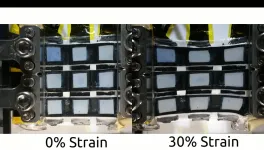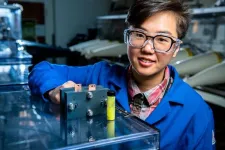New book explores the psychology of being duped
Nobody's Fool: Why We Get Taken In and What We Can Do About It
2023-07-11
(Press-News.org) CHAMPAIGN, Ill. — According to two psychologists who study memory and perception, fraudsters tend to exploit the common habits of thought and decision-making that make us susceptible – and often oblivious – to their fabrications. Their book, “Nobody’s Fool: Why We Get Taken In and What We Can Do About It,” gives readers an overview of dozens of types of scams, hoaxes and strategies used by cheaters to deceive, and explains how to evaluate their ploys and avoid becoming a victim.
The authors, Daniel Simons, a professor of psychology at the University of Illinois Urbana-Champaign, and Christopher Chabris, a cognitive scientist who has taught at Union College and Harvard University, are already known for “The Invisible Gorilla,” a book that explored the limits of human perception with studies showing that intense focus on one kind of stimulus can blind us to other obvious details of a scene.
Their new book shows how common psychological habits can get us into trouble when we become the target of efforts to deceive us. The human tendency to trust seemingly familiar sources or information we have seen repeatedly, the assumption that consistency is a mark of integrity, our tendency to overvalue our assumptions without checking them carefully, and our reluctance to ask more questions – these and other traits can make us easier to fool.
“Nobody’s Fool” gives numerous examples of the mechanisms driving fraudulent scientific reports, Ponzi schemes, phishing attacks, computer-assisted cheating, art forgery, and deceptive political and business practices. Such trickery can rob us of our access to reliable information, fair elections and, of course, our money.
All of these scams rely on common human psychological tendencies, the authors write. For example, we have a basic tendency to believe that what other people tell us is true.
“Truth bias is a feature, not a bug,” they write. Most people are honest most of the time, so it makes sense that we do not question every statement from every person we encounter.
“But truth bias is also an overarching factor that plays a role in every con, scam and fraud,” they add. This leaves us with a conundrum: “We need to believe others, but if we trust too much, we’re in trouble – especially now.”
The book urges readers to engage in a number of practices that will help them navigate murky waters and avoid being scammed. These include accepting less of what they’re told – even by friends and close acquaintances – and checking the facts more often, especially when making big decisions. The authors urge readers to ask more questions, be wary when they’re told something that perfectly fits what they believe and expect to hear, and pay attention to what isn’t said or isn’t included in demonstrations or presentations.
The authors also describe how easy explanations, perfect results or a lack of at least some random variation in the data offered to support a particular conclusion should all be viewed as red flags by anyone hoping to ferret out deceit.
Throughout the book, the authors provide examples of the sorts of questions we can ask ourselves – and others – to make sure that our habits are working for us rather than for people looking to cheat us.
Editor’s notes:
To reach Daniel Simons, email prof.simons@gmail.com.
To reach Christopher Chabris, email chabris@gmail.com.
“Nobody’s Fool: Why We Get Taken In and What We Can Do About It” is available from Basic Books.
Members of the media may contact Liz Wetzel or Katherine Robertson to request a review copy of the book.
To reach Liz Wetzel, call 212-364-0661; email Liz.Wetzel@hbgusa.com.
To reach Katherine Robertson, call 212-364-0559; email Katherine.Robertson@hbgusa.com.
Hardcover: 336 pages
ISBN-10: 1541602234, ISBN-13: 978-1541602236
Kindle: ASIN: B0BLNDRL8V
Audible: ASIN: B0BLXBGWRB
Audio COULD: ISBN-10: 1668635984, ISBN-13: 978-1668635988
END
ELSE PRESS RELEASES FROM THIS DATE:
2023-07-11
ARLINGTON, Va. (July 11, 2023) — Five medical societies have published a set of recommendations for operationalizing strategies for infection prevention in acute care settings that account for conditions within the facility, including the culture and communications style of teams, hospital policies, resources available, leadership support and staff buy-in.
“There is no best way to implement a practice, but implementation need not be overly complex,” said Joshua Schaffzin, MD, a pediatric infectious disease physician and a senior author of Implementing Strategies to Prevent ...
2023-07-11
A new analysis shows that there are probably many more Earth-like exoplanets with liquid water than had been thought, significantly increasing the chance of finding life. The work finds that even where the conditions are not ideal for liquid water to exist at the surface of a planet, many stars will harbour geological conditions suitable for liquid water under the planet’s surface.
Presenting the work at the Goldschmidt geochemistry conference in Lyon, lead researcher Dr Lujendra Ojha (Rutgers University, New Jersey, USA) said “We know that the presence of liquid water is essential for life. Our work shows that this water can be found in places ...
2023-07-11
Hairdressers, beauticians, and accountants are among certain job roles that may be associated with a heightened risk of ovarian cancer, finds a case-control study published online in the journal Occupational & Environmental Medicine.
Those working in sales, retail, clothing and construction industries may also be vulnerable, while high cumulative exposure to particular agents, including talcum powder, ammonia, propellant gases, petrol and bleaches may have an important role, the findings suggest.
Few modifiable risk factors for ovarian cancer have been identified. Environmental factors, ...
2023-07-11
Fibromyalgia, a condition that causes persistent widespread pain and fatigue, may be linked to a heightened risk of death as a result of vulnerability to accidents, infections, and especially suicide, suggests a pooled data analysis of the available evidence, published in the open access journal RMD Open.
The findings prompt the researchers to call for regular monitoring of patients’ physical and mental health to minimise these risks.
It’s not clear what causes fibromyalgia, but its prevalence is increasing, say the researchers. And there’s growing recognition that the condition often coexists with other health problems, ...
2023-07-11
There are significant variations in healthcare spending and care delivery across NHS hospitals in England and Wales following hip fracture, a new study aimed at understanding how hospital care impacts patients’ outcomes and costs has revealed.
The study, led by the University of Bristol and funded by Versus Arthritis, highlights the urgent need for evidence-based quality improvement strategies to reduce healthcare spending and improve patient outcomes in the year following a hip fracture. The research is published online in The Lancet Healthy Longevity today ...
2023-07-10
The quantum nature of interactions between elementary particles allows drawing non-trivial conclusions even from processes as simple as elastic scattering. The ATLAS experiment at the LHC accelerator reports the measurement of fundamental properties of strong interactions between protons at ultra-high energies.
The physics of billiard ball collisions is taught from early school years. In a good approximation, these collisions are elastic, where both momentum and energy are conserved. The scattering angle depends on how central the collision was (this is often quantified by the impact parameter value – the distance between the centres of ...
2023-07-10
ITHACA, N.Y. -- Unused solar, wind, and hydroelectric power in the U.S. could support the exponential growth of transactions involving non-fungible tokens (NFTs), Cornell Engineering researchers have found.
Fengqi You, the Roxanne E. and Michael J. Zak Professor in Energy Systems Engineering in Cornell Engineering, is corresponding author of “Climate Concerns and the Future of Non-Fungible Tokens: Leveraging Environmental Benefits of the Ethereum Merge,” which published July 10 in Proceedings of the National Academy of Sciences. You’s co-author is Apoorv Lal, ...
2023-07-10
With support from Amplicore, a University of Cincinnati spinoff biopharmaceutical company, researchers at UC have begun a Department of Defense-funded clinical trial that seeks a regenerative pharmaceutical solution for meniscal tears.
Each year more than 500,000 people in the United States sustain acute tears in their meniscus, a piece of cartilage in the knee that cushions and stabilizes the joint. This rate is even higher in the military population, where such injuries can greatly impact the ability of servicemen and women to perform their duties.
The Phase 1/2 clinical trial enrolled its first patients in Cincinnati with Brian Grawe, ...
2023-07-10
Imagine a wearable patch that tracks your vital signs through changes in the colour display, or shipping labels that light up to indicate changes in temperature or sterility of food items.
These are among the potential uses for a new flexible display created by UBC researchers and announced recently in ACS Applied Materials and Interfaces.
“This device is capable of fast, realtime and reversible colour change,” says researcher Claire Preston, who developed the device as part of her master’s in ...
2023-07-10
RICHLAND, Wash.—A common food and medicine additive has shown it can boost the capacity and longevity of a next-generation flow battery design in a record-setting experiment.
A research team from the Department of Energy’s Pacific Northwest National Laboratory reports that the flow battery, a design optimized for electrical grid energy storage, maintained its capacity to store and release energy for more than a year of continuous charge and discharge.
The study, just published in the journal Joule, details the first use of a dissolved simple sugar called β-cyclodextrin, a derivative of ...
LAST 30 PRESS RELEASES:
[Press-News.org] New book explores the psychology of being duped
Nobody's Fool: Why We Get Taken In and What We Can Do About It








